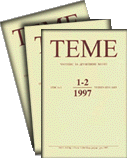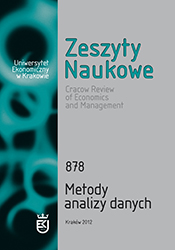
We kindly inform you that, as long as the subject affiliation of our 300.000+ articles is in progress, you might get unsufficient or no results on your third level or second level search. In this case, please broaden your search criteria.








Every ethnicity has more or less rounded complex of ethnic, religious, and cultural characteristics. Their collection makes what we understand under notion "identity". Members of an ethnicity differ from other ethnic groups in respect to that identity. Of course, "clear' identity does not exist, but it is a fact that historically "older" nations have stronger identity while similar and "small" peoples insist extremely on identity differentiations; this influences their relations and can lead to intolerance and conflicts, even war. The question of globalization, which can damage identity of small peoples, was a topic of discussion at round table "Globalization, Acculturation, and Identity in Balkan", which was held on 12. December, 2002 at the Faculty of Philosophy in Nis, as a part of project "Cultural and Ethnic Relations in Balkan – Possibilities for Regional and European Integration". Reports from this round table will be presented after introductory article.
More...
Analiza statystyczna zróżnicowania wykorzystania środków unijnych przez polskie regiony szczebla NUTS 2 w okresie od stycznia 2007 roku do czerwca 2010 roku Poland is the largest beneficiary of the EU’s cohesion policy, scheduled for years 2007–2013. During this period, the European Union will grant projects under the Convergence objective and the European Territorial Cooperation objective to the tune of € 67.3 billion. Along with national co-financing the total value of projects using EU funds will amount to € 85.6 billion. The authors believe the midpoint of the EU’s ongoing financial plan is an appropriate time to assess the diversity of participation among Polish regions in the European Union’s cohesion policy. The aim of their research is to conduct statistical analysis of the diversification of EU fund use to achieve the objectives of European cohesion policy by the Polish NUTS 2 regions for the period from January 2007 to June 2010. The verification of hypotheses formulated, referring to the realisation of economic and social cohesion, is based on indicators proposed by European Commission. In turn, the authors propose indicators for determining the level of technical infrastructure development in order to study the realisation of territorial cohesion. They also discuss new and current applications of statistical methods.
More...
The authors present an example of the application of cluster analysis in commodity science. The aim of the analysis was to find, on the ground of chemical composition, groups of mineral and spring waters in which the objects of the same group exhibited the highest possible degree of similarity, while objects of different groups exhibited the lowest. Euclidean distance method was used to calculate the distance between the objects. The agglomerations were created by using the nearest neighbour algorithm.
More...
Reducing the size of an organisation and process optimisation are the most frequent methods used to prepare a company for a period of economic slowdown. In both methods, information technology, especially ERP class systems, are basic tools for achieving goals. To support this thesis, the article presents two cases of implementing information technology tools. The first examines the implementation of an ERP system in a technology company specialising in information technology integration service. Technology companies are an example of organisations managed by projects in which the slimming process is extremely complicated and requires enormous amounts of information. The second case presents the implementation of a B2B platform – an electronic data exchange between a large distribution company and its partners, suppliers and forwarding agents. The case presents the range of measurable advantages of process cost optimisation that can be achieved owing to the use of information technology. The article’s summary examines the problem of how, according to the thesis of the expediency of investment into ERP systems, the market of these systems behaved in Poland during the most recent period of economic slowdown.
More...
EU enlargement has brought about geographical reorientation and the intensification of foreign trade among many new EU members, including the four new members of East Central Europe. Particularly, the importance of vertical and horizontal intra-industry trade has increased in these countries, as has the value of FDI. How FDI influences intra industry trade types in East-Central European countries is an interesting question that the paper tries to answer through the application of panel data models. Data from Eurostat about foreign direct investment, export and import in manufacturing industries in the years 2000–2008 are used in the research.
More...
The aim of the paper is to identify the socio-economic conditions of household participation in culture and relaxation. A double-track analysis of household expenditures has been carried out. First, the dynamics of the level and structure of expenditures is carried out based on aggregated data for the years 1998–2008 published by the Central Statistical Office. The second part is based on a 2008 CSO analysis of 37,358 household budgets. Econometric models enabled the set of variables to be estimated. Whether positive or negative, the variables have a statistically significant influence on household expenditures on culture and relaxation.
More...
The paper presents developments in Poland and Ukraine in the years 1991–2009, focusing on the similarities and differences in the macroeconomic environment of the two countries. A pentagon of macroeconomic stabilisation is a basis for presenting the differences in the basic macroeconomic indicators in the two countries, while the “golden rule of economic growth” verifies the overall effectiveness of the two economies. The paper also presents projections for an increase in GDP in Poland and Ukraine in the context of the co-organisation of EURO 2012. The results of the analysis indicate different GDP growth rates in the two countries despite the similarities in their phases of economic development. The period of recession in Poland was exceptionally short, enabling the country to resume accelerated economic growth. Ukraine, despite a more drawn out transformation recession, has managed to catch up with Poland and other post-Communist countries that have become members of the EU. Economic growth projections for Poland and Ukraine until 2015 are 4.5%–5.5%, and 5.5%–6%, respectively, which might be attributed to the integration of the two countries with the European economy and the implementation of permanent economic growth policies.
More...
The article assesses the level of economic internationalisation and the socio-economic development of Poland’s regions and determines the correlations between the two phenomena. The analysis is based on several indices divided into ten components characterising the processes of internationalisation and socio-economic development. Instead of the standard procedure for verifying the preliminary list of indices (mostly based on correlation indices), a simulation has been used – 10,000 sets of random chosen indices to calculate the composite indices for each component. The final composite measures have been calculated as the mean of those 10,000 composite indices. This procedure allowed the authors to identify the differences in final results of analysis emerging from different sets of indices taken to assess the composite measures.
More...
Using quarterly data for the years 2003–2010, the authors describe the coking coal, coke and steel markets to determine whether there is a correlation between the market prices of coke, coking coal and steel. Coke, coking coal and scrap are all used to produce steel, and therefore the price of steel should depend on these raw materials. The price of steel also depends mainly on economic conditions. Vector autoregression models (VAR) are employed in the analysis.
More...
The paper presents numerical issues related to the estimation of dynamic general equilibrium models with Bayesian techniques. As an illustrative example, a simple New-Keynesian model with nominal rigidities in price and wage settings is taken from the literature. Estimating structural parameters requires the application of numerical methods – optimization algorithms for maximum likelihood and Monte Carlo techniques for the Bayesian estimation of the Markov Chain. A broad literature that treats the estimation of dynamic macroeconomic models rarely presents any aspects of the numerical side of applications and its potential impact on results and inference. The paper concentrates on the issue of convergence criteria of the Markov Chain Monte Carlo techniques and the methods of monitoring parameter stability.
More...
A critical review on Thoma Laqueur's "A testet öltött nem [Making Sex]".
More...
Éva Kocziszky on Max Picard's "A csend birodalma [The World of Silence]", Melinda Kovai on Miklós Kontra's (ed.) "Nyelv és társadalom a rendszerváltáskori Magyarországon [Language and Society in Hungary in the Period of Transition]", Ágnes Erdélyi on Ádám Nádasdy's "Ízlések és szabályok [Tastes and Rules]", Eszter Somorjai on Árpád Kékes Kun's "Thália árnyék(á)ban [Under Thalia's Shadow or Thalia in the Shadow]", Csaba Dupcsik on Pál Léderer's "A szociológus, a módszerei meg a szövege [The Sociologists, Their Methods and Their Discourse]", Ágnes Huszár on Margaret Mead's "Férfi és nő [Male and Female]", Bernadette Somody on Dr. Zolátn Galántai's "E-privacy olvasókönyv [E-Privacy Reader]" and Máté Dániel Szabó's (ed.) "Védett adataink [Our Protected Data]", Éva Simon on Gábor Halmai's "Kommunikációs jogok [Communication Rights]" and Péter Molnár's "Gondolatbátorság [Courage of Thought]", and G. Péter Tóth on Paul Boyer's, Stephen Nissenbaum's "Boszorkányok Salemben [Salem Possessed]".
More...
A bibliography of the important Hungarian books published in Summer 2003.
More...